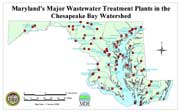|
Dock of the Bay
 A Royal Flush A Royal Flush
Chesapeake Bay dealt winning hand with new nutrient limits
Two dollars 50 cents is a small price to pay for big changes.
Since the first flush of the new year, you and all your Maryland neighbors have been helping make big changes. You're sending $2.50 each month flowing toward Bay restoration.
Your money will so purify our wastewater that oysters may better breathe and Bay grasses may again flourish.
Maryland's flush tax is a long-awaited step in the right direction.
Soon, all six states within the Bay watershed - from New York to Virginia, as well as the District of Columbia - will be following suit. Three years in the making, a new EPA contract with those states, announced January 3, limits the amount of nutrients municipal and industrial wastewater treatment facilities throughout the Bay watershed can release into waterways.
Maryland is already pushing and funding its own limits.
Gov. Robert Ehrlich's new Bay Restoration Fund, dubbed the flush tax, gives grants to wastewater treatment plants to reduce nutrient pollution spilling out of their facilities into Chesapeake Bay.
To pay for these upgrades, Marylanders will see a monthly $2.50 fee tacked onto water or sewer bills. Homes that benefit from wastewater treatment plants will see the fee on their post-new year's bills. Apartment dwellers may see the tax passed on through higher rent. From these flushes, Bay restoration will gain $65 million per year.
Septic users will pay their share, too, with a $30 annual fee to their county government to come after October 1.
More than half the funds from Maryland's 420,000 septic systems will pay for septic upgrades; the rest will pay for cover crops to help slow water runoff. Maryland anticipates collecting more than $12 million a year from septic users for the upgrades and cover crops.
The millions from wastewater treatment plant users will upgrade Maryland's 66 major water treatment plants, which release 500,000 gallons of water every day into the Chesapeake Bay. By 2011, these upgraded plants will fine-filter nutrients with up-to-date technology. Then, additional funds will finance smaller plants.
The new nutrient filtering technology, known as enhanced nutrient removal, gets even more nitrogen and phosphorus out of the water than the nutrient-eating microbes most frequently used today. That means only three milligrams per liter of total nitrogen and 0.3 milligrams per liter of phosphorus escape into waterways, instead of the eight milligrams allowed by biological nutrient removal. It may be a drop in the bucket, but added up, those drops make for clearer water.
While small doses of nutrients give life to the Bay, in excess, those same nutrients cause phytoplankton blooms, as masses of algae block sunlight and consume dissolved oxygen. Pulling in the reins on nutrients released into the Bay means more oxygen for Bay creatures and more sunlight for aquatic plants.
Eight of the 66 major plants are in Anne Arundel County and one in Calvert County, at Chesapeake Beach.
"We've already initiated several upgrades," said Maryland Department of Environment's Robert Summers. Two plants, one in Easton and one in Alleghany County, have already upgraded to the enhanced nutrient removal.
Renovations are moving along for other plants, too: the plans for seven facilities are being re-drawn, and experts are figuring out the best ways to upgrade 27 plants.
Other states don't yet measure up to Maryland's flush fee.
"Virginia and Pennsylvania have all taken steps - though none as aggressive as Maryland's," said Ann Swanson, executive director of the Chesapeake Bay Commission.
Last week's EPA agreement between the Bay watershed's six states and the District made standards uniform in 350 municipal and industrial wastewater treatment facilities throughout the 64,000-square-mile watershed.
"One of the great things about this agreement is that the EPA worked with the states from the beginning," said EPA Chesapeake Bay Office's Chris Conner. "The consensus approach is a different way to pass something like this."
The cooperative effort, which stemmed from the Chesapeake 2000 agreement, was created through partnerships of the Bay Commission working with headwaters partners and the Bay program.
"They realized that the only way to meet reduction goals is to bring in the headwater states to reduce nutrients from these parts," Conner said.
The partners got help from each state's river tributary strategies team in deciding how much nitrogen and phosphorus would be allowed to come from each of the major river basins.
In all, we can expect 20 percent less nitrogen and phosphorus washing into our waters from wastewater treatment plants. Much of the rest comes from such non-point sources as air and over-land runoff. "Agriculture is a big chunk of that non-point source pollution," said EPA's Bob Koroncai.
EPA's new agreement only allows 175 million pounds a year of nitrogen and 12.8 million pounds a year of phosphorus into the Bay. On the flip side, the agreement should stop about 17.5 million pounds of nitrogen and about one million pounds of phosphorus from entering the Bay each year. The new limits set the stage for good water quality, Conner says.
The Chesapeake Executive Council's January 10 meeting charted the way for watershed-wide Bay restoration funding. The Council - made up of the governors of Maryland, Pennsylvania, and Virginia; the administrator of the U.S. EPA; the mayor of the District of Columbia; and the chair of the Chesapeake Bay Commission - said they expect to hear by July 1 a proposal outlining how the financing authority will be governed.
The watershed will need to come up with $15 billion to upgrade the Chesapeake's 350-plus treatment plants and keep nutrients under wraps: $12 billion will come from federal funding and $3 billion from states.
"We need the best and the brightest to figure out how to come up with the funds," said Swanson.
Here in Maryland, every flush of the toilet - and the sound of each whooosh! - means your pennies are going toward a cleaner Bay.
Want to know much more? The Maryland Onsite Association updates advances in septic system technology on Jan. 21 @ Sheraton Hotel, Annapolis: 410-798-1697.
-Carrie Steele
 In New Session, Democratic Leaders Ride Different Horses In New Session, Democratic Leaders Ride Different Horses
Senate president wants slots; House speaker balks
"When you get into public office, you decide what you believe in," Democratic House Speaker Michael Busch told a cheering breakfast club of Annapolis Democrats looking ahead to the new session.
"I got here as a teacher, and I believe in quality education," he said.
Who's not for quality education? But how to pay for this shared goal promises to again divide the Democratic leadership of the General Assembly this year.
For Busch, a former high school teacher and coach, slot machines are the wrong way. "I think it's a poor comment on leadership to make gambling the foundation of our state budget and educational system," Busch said.
Across the State House's great marble forum, Busch's counterpart in the Senate thinks differently.
"The issue is slots versus taxes," Maryland's Democratic president of the senate told the Calvert County Chamber of Commerce over another breakfast meeting. "We're losing $6 million a year to our sister states, and we need that money to build schools.
"Slots are not going to be next door in your neighborhood. They're going to be at racetracks. And more of 50 percent of the money they bring in will go back to the state, most for education," said the Senate president, who has held that job since 1987, longer than any other in state history.
So he is a man who speaks his mind, and for the failure of slots two years running he lays blame on his House counterpart, Busch, only two years on the job.
"Sometimes it takes a while, but I'm going to push slots through," Miller promised. "It's imperative."
-SOM
 Anne Arundel's January Greeting: "Dear Legislator" Anne Arundel's January Greeting: "Dear Legislator"
Everybody who wants a law is making a list and checking it twice
Santa has handed off the job, and now it's legislators who are getting everybody's list. If you've got a wish, these are the days to whisper it in your senator or delegate's ear.
Every place you go in Annapolis - and back in home districts, too - legislators draw a crowd this time of year. At breakfasts, receptions and happy hours; in legislative halls, around town and outside on smoking breaks hopefuls surround them.
"We have a deadline. You have to get bills drafted and filed by mid-February," explains Anne Arundel County Sen. John Astle of the early rush. "So everybody shows up with bills now - or earlier.
As the legislative session opened, Anne Arundel County Executive Janet Owens bought her delegation breakfast at Harry Browne's in Annapolis in hopes they'd make her wishes come true.
From preserving the county's state funding to bestowing the fire department with new powers to investigate crimes, most wishes found willing supporters. Only one got left out in the cold: When Owens said, "I'm looking for a sponsor for a county cell-phone tax," legislators and county council members groaned.
Del. Virginia Clagett, a member of Astle's District 30 ABC Team (that's Astle, Busch and Clagett), hopes to make wishes come true for YMCA Camp Letts in Edgewater.
"They've been trying for years to add to their wastewater treatment so they can expand the number of kids the camp serves," Clagett says. "Now they've gotten matching funds from the county and federal funds from Congressman Steny Hoyer, so it's up to us."
Hopefuls also sought the ear of Del. Herb McMillan, a Republican who two years ago erased the D from District 30's Democratic team in more ways than one when he unseated Del. Dick D'Amato.
"Some requests are minor," says McMillan, a former Annapolis councilman who has long sought higher office. One of those was the rental property owner who sought a reduction in the interest paid on tenants' security deposits.
"Please don't make us pay more interest than we get on the money in the bank.' That's what that one wanted," McMillan recounts.
Some wishes take years to come true. This session, McMillan seeks to make good on a wish deferred from 2004.
At the beginning of the last year's session, a coalition of environmental groups sent long wish lists to all Maryland lawmakers. The Green Budget, as it was called, suggested funding environmental projects with state money wastefully spent elsewhere. Among those ideas was ending subsidies for Maryland-produced coal.
"I don't like subsidies," the conservative Republican says.
This subsidy pays power companies a $3 tax credit for every ton of Maryland coal they buy. By McMillan's reckoning, that amounts to $16 million each year to subsidize Maryland coal plants.
Last year, McMillan was allied with other legislators who offered support but then withdrew it.
"I'm going to offer it again this year," McMillan said, "and ask the money to be directed to Project Open Space."
Project Open Space funds the purchase and protection of public lands throughout the state.
"I see that as a good bill," McMillan said. "It's fiscally conservative and environmentally responsible."
-SOM
Ask the Plant Professor Foiling Foraging Fiends Foiling Foraging Fiends
Q Do deer like lilac bushes?
A Lilacs are not on the top of their preferred menu, but the bottom line is deer will eat just about any plant if they are hungry enough. Lilac and many other plants will suffer browse damage when young but are ignored when they reach some size. Crape myrtle and boxwoods are two safe alternatives. For lists of plants arranged by degree of resistance, see our publication FS655, Resistance of Woody Ornamentals to Deer Damage.
Q I've tried everything to keep raccoons from destroying my bird feeders, short of trapping and destroying them. Any last-ditch suggestions? I'd like to live and let live with nature if at all possible.
A Raccoons are nocturnal. Simply take in the bird feeders at night when the birds will not be feeding anyway.
Pushing Spring
Q I have window space in my bedroom, where I would enjoy growing an herb. I hope that you can give me a few plant choices that would be right for me.
A Herbs like lots of sun. If your window faces south, you could grow basil, chamomile, chervil, chives, coriander, Corsican mint, dill, garlic chives, lemon balm, oregano, parsley, peppermint, rosemary, sage, sweet marjoram, tarragon or thyme.
Q How soon can I transplant holly in the spring?
A Holly, as well as most woody plants and perennials, can be transplanted as soon as the soil is workable. Workable means that soil should not be frozen or too wet. It's too wet when a handful of soil squeezed into a ball does not break apart easily when gently bounced in your hand.
Ask the Plant and Pest Professor is compiled from questions sent to the website of the Home and Garden Information Center, part of Maryland Cooperative Extension, an educational outreach of the University of Maryland. Ask a home gardening or pest control question and find other help: 800-342-2507 (Mon.-Fri. 8am-1pm) • www.hgic.umd.edu.
Way Downstream
In Washington, leaders from Bay states are pressing the federal government for Everglades-like clean-up money to speed up Chesapeake restoration. The Chesapeake Executive Council, made up of state officials and feds overseeing Bay programs, voted to seek $12 billion in the 109th Congress just getting underway
In Kentucky, at 360 miles Mammoth Cave National Park is the longest cave system in the world. That hasn't stopped the National Park Service from entertaining a proposal to build a 185-foot-high cell phone tower at the park. Conservationists are fighting to derail the plan …
From Texas (where else?) comes the epitome of vehicular excess, the Bad Boy Heavy Muscle Truck, 21 feet long, 10 feet tall and 13,000 pounds, built to protect the truly paranoid from dirty-bomb radiation, chemical agents and even biological attack. Built by a company called Stewart & Stevenson, it makes the Hummer look like a go-cart and starts at $200,000 with loaded luxury models topping out at $750,000
Our Creature Feature comes from Kenya, where an unusual friendship has sprouted between unusual creatures - a 120-year-old giant tortoise named Mzee and an ailing baby hippo. When they released Owen into a Nairobi wildlife sanctuary after he was rescued from a river, the hippo made a beeline for the tortoise, dark gray like himself. Since then, the two have become inseparable, Reuters reports. But alas, this good thing will be ending; Owen is scheduled to be relocated soon to new quarters with one of his own - a lonely female hippo named Cleo.
to the top
|


 A Royal Flush
A Royal Flush In New Session, Democratic Leaders Ride Different Horses
In New Session, Democratic Leaders Ride Different Horses Anne Arundel's January Greeting: "Dear Legislator"
Anne Arundel's January Greeting: "Dear Legislator"  Foiling Foraging Fiends
Foiling Foraging Fiends